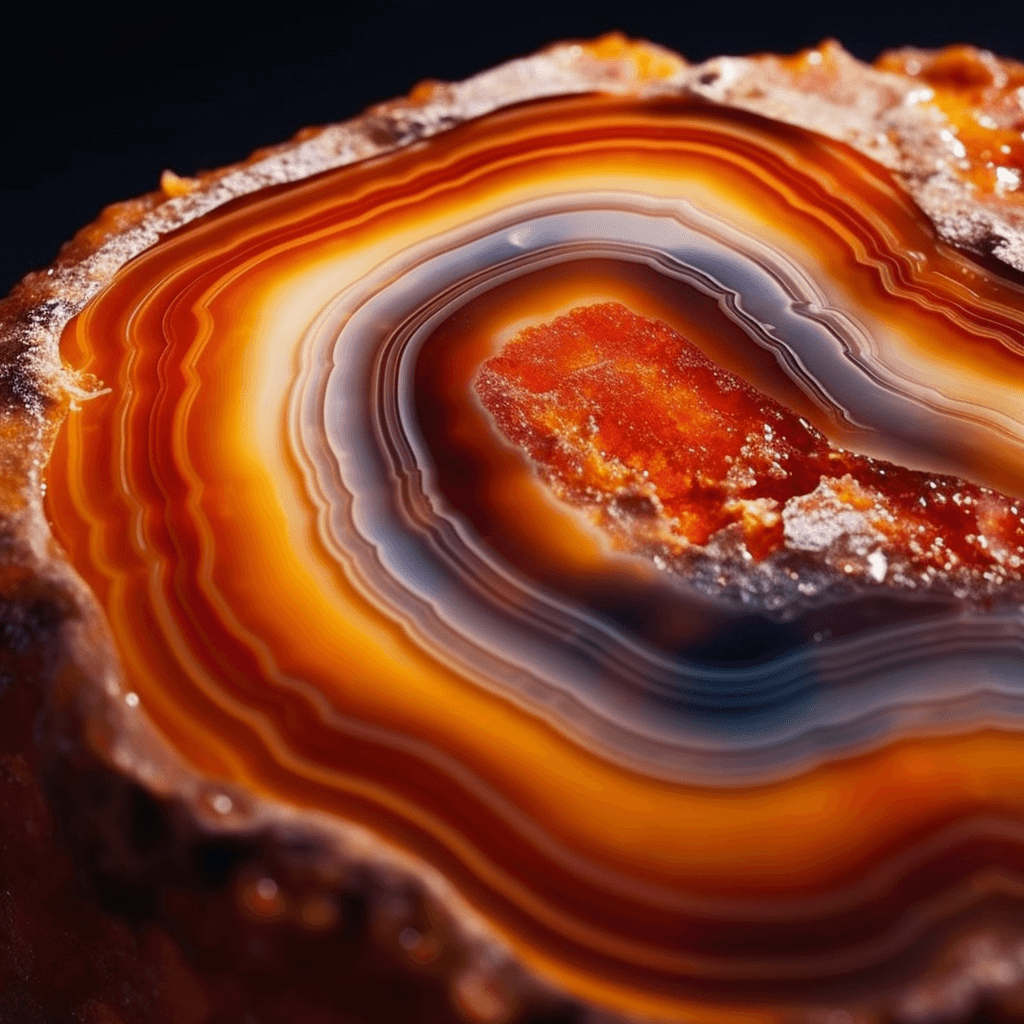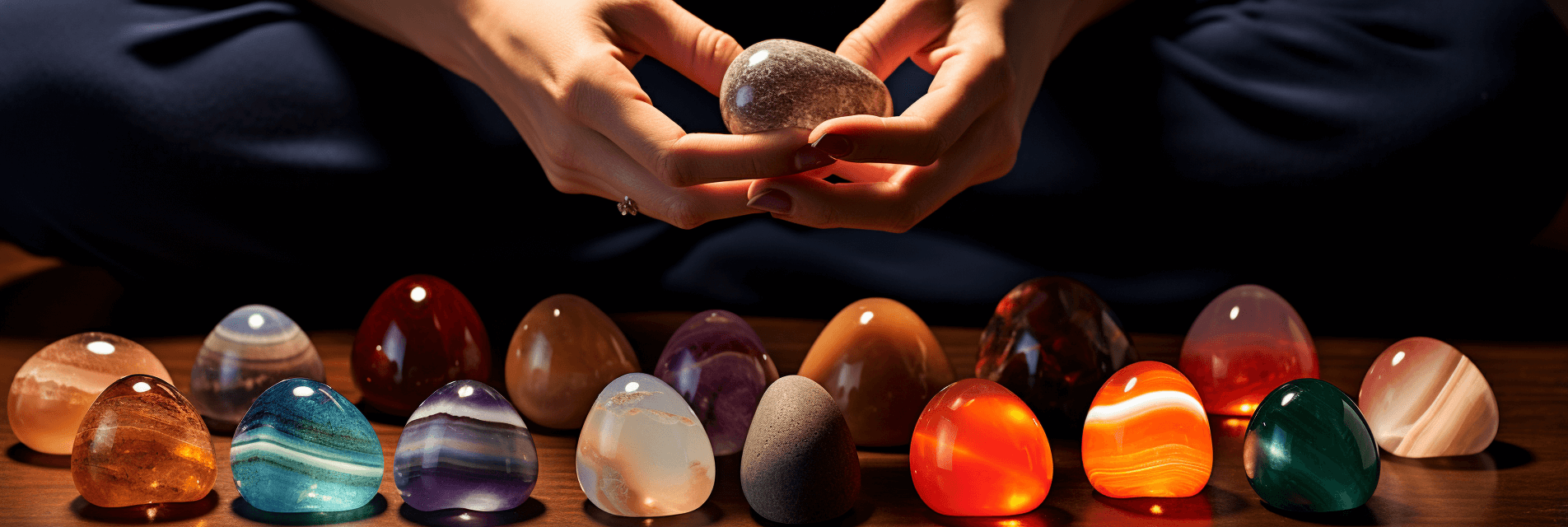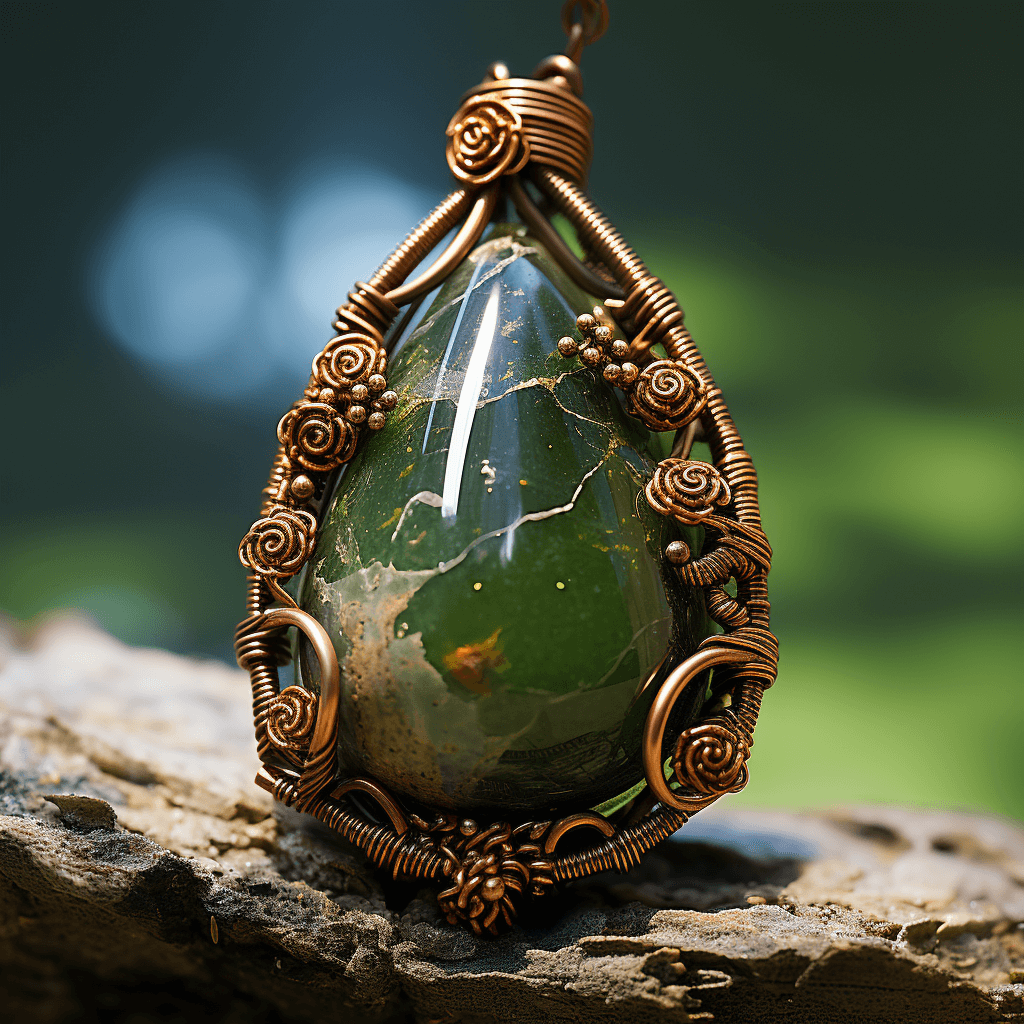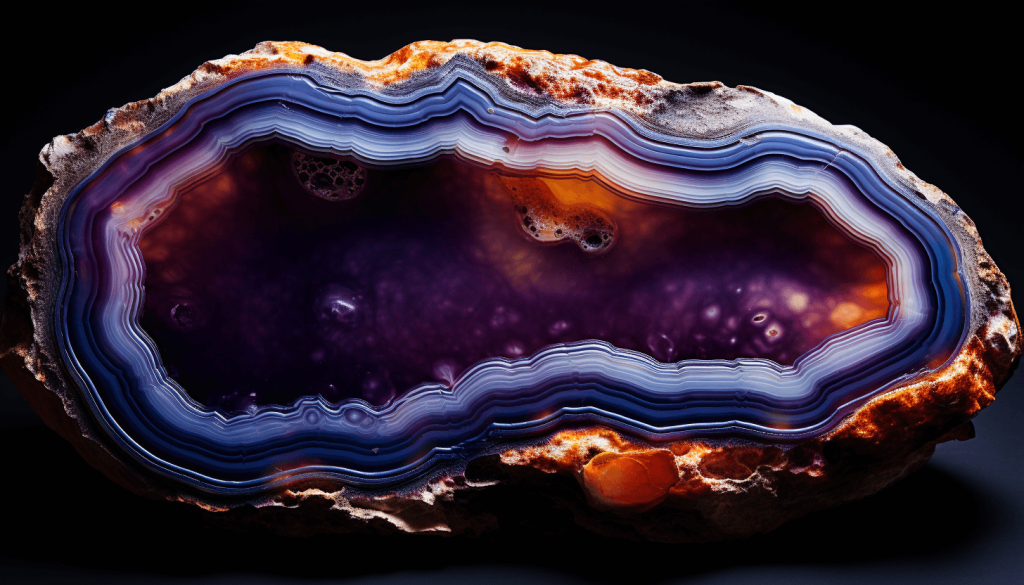Agate is a captivating variety of banded chalcedony, a mineral of the quartz family. Distinguished by its multiple layers of striking colors and patterns, agate has been revered for centuries for both its beauty and perceived healing properties.
Introduction to Agate: A Glimpse into the World of Banded Chalcedony
Originating from volcanic rock, agate forms when silica-rich solutions fill cavities and solidify over time. The unique banding patterns are a result of the slow crystallization process, where different layers of silica are deposited in sequence. This mesmerizing stone has been discovered in various parts of the world, from the scorching deserts of Africa to the icy terrains of Siberia.
Throughout history, agate has been utilized in various ways. From being crafted into jewelry and ornaments to serving as talismans and amulets, its allure is undeniable. Beyond its aesthetic appeal, many cultures have attributed spiritual and healing properties to agate, believing it to bring balance, strength, and protection to its bearer.
Formation of Agate: Geological Processes and the Beauty of Patterns
Agate’s formation is a testament to the wonders of geological processes. Over millions of years, the interplay of minerals, temperature, and pressure crafts this gemstone, giving it its distinctive appearance.
Geological Properties
Agate primarily consists of silicon dioxide, or SiO2. Its hardness on the Mohs scale is around 6.5 to 7, making it relatively durable and resistant to scratches. The stone’s specific gravity typically ranges between 2.58 to 2.64.
| Property | Value |
|---|---|
| Chemical Composition | SiO2 |
| Hardness (Mohs scale) | 6.5 to 7 |
| Specific Gravity | 2.58 to 2.64 |
| Transparency | Translucent to Opaque |
| Luster | Waxy to Vitreous |
| Refractive Index | 1.530 to 1.540 |
| Crystal System | Hexagonal |
The formation of agate begins in cavities of volcanic rocks or ancient lavas. As groundwater, rich in silica, seeps into these cavities, it begins to deposit in layers. Over time, these layers solidify and crystallize, leading to the banded patterns that agate is renowned for. The variations in color and design are influenced by changes in temperature, pressure, and mineral content during its formation.
It’s this intricate process, shaped by nature’s forces, that results in every piece of agate being unique, with its own story to tell.
Varieties and Colors of Agate: From Blue Lace to Moss Agate
| Variety | Description |
|---|---|
| Blue Lace Agate | Characterized by its soft blue hues with white or light blue bands, resembling lace. |
| Moss Agate | Not truly banded, it has inclusions that resemble moss or trees. |
| Crazy Lace Agate | Known for its intricate patterns and vibrant colors, often resembling lacework. |
| Tree Agate | White with green dendritic inclusions, resembling trees or shrubs. |
| Fire Agate | Displays a fiery play of colors, including reds, oranges, and browns. |
| Dendritic Agate | Clear or milky white with tree-like dendrite inclusions. |
| Botswana Agate | Known for its fine bands of white, pink, salmon, mauve, and brown. |
| Banded Agate | Distinct layers or bands of color, often in a concentric pattern. |
| Indian Agate | A variety of colors and patterns, often used for jewelry in India. |
| Laguna Agate | Renowned for its vibrant colors and tight banding patterns. |
| Lake Superior Agate | Rich reds, oranges, and yellows, found mainly around Lake Superior. |
| Sardonyx | A blend of sard and onyx with colored bands; not always considered a type of agate. |
| Eye Agate | Contains ring shapes or “eyes” in its pattern. |
| Enhydro Agate | Contains water trapped inside, often seen as bubbles. |
| Carnelian Agate | Reddish-orange in color, often just referred to as Carnelian. |
| Plume Agate | Has feather-like inclusions, often in red, black, or brown. |
| Fortification Agate | Displays patterns resembling the outlines of fortifications or walls. |
| Snakeskin Agate | Resembles the skin of a snake with a scaly appearance and texture. |
Healing Properties of Agate: Energies for Emotional, Physical, and Mental Well-being

For centuries, agate has been revered not just for its aesthetic allure but also for its purported healing properties. Across different cultures and eras, this gemstone has been believed to harness energies that can positively impact emotional, physical, and mental well-being.
Emotional Healing
Agate is often considered a stone of strength and courage. It is believed to help individuals confront their fears and anxieties, fostering a sense of security and stability. Many also turn to agate to enhance self-confidence, self-acceptance, and self-love, making it a powerful ally in emotional healing and personal growth.
Physical Healing
On a physical level, agate is said to have a soothing effect. Some believe it can aid in digestion, ensuring a smooth metabolic process. Additionally, it’s often associated with improving vision and healing skin disorders. Some cultures even believe that agate can help in detoxifying the body and strengthening the heart.
Mental Healing
For those seeking clarity of mind, agate is a gemstone of choice. It’s thought to enhance mental function, improving concentration, analytical skills, and perception. By dispelling negative energies and thoughts, agate can pave the way for a calm mind, aiding in decision-making and problem-solving.
Agate and the Chakras: Aligning and Balancing the Energy Centers
Chakras, the energy centers of the body, play a pivotal role in spiritual and holistic practices. Agate, with its diverse range of colors and properties, is believed to resonate with multiple chakras, aiding in their alignment and balance.
Root Chakra (Muladhara)
Red and brown varieties of agate, such as the Red Agate or Fire Agate, are often associated with the Root Chakra. This chakra, located at the base of the spine, governs our feelings of security and grounding. Agate’s stabilizing properties can help in anchoring one’s energy and fostering a sense of safety.
Sacral Chakra (Svadhisthana)
Orange-toned agates, like the Carnelian Agate, resonate with the Sacral Chakra. Positioned below the navel, this chakra is the center of creativity, passion, and pleasure. Agate’s energizing properties can stimulate this chakra, enhancing vitality and zest for life.
Heart Chakra (Anahata)
Green agates, such as Moss Agate and Tree Agate, are believed to connect with the Heart Chakra. This energy center, located in the chest, governs love, compassion, and emotional balance. The nurturing energies of agate can promote feelings of love, both for oneself and for others.
Throat Chakra (Vishuddha)
Blue Lace Agate, with its soft blue hues, is often linked to the Throat Chakra. This chakra, situated in the throat, is the center of communication and self-expression. The calming energies of Blue Lace Agate can aid in clear communication and self-expression without anger or resentment.
Agate’s versatility in chakra healing is further amplified when combined with meditation or crystal layouts, enhancing its ability to balance and align the energy centers of the body.
Folklore and Mythological Tales: Agate in Ancient Cultures and Civilizations
Agate’s allure transcends its physical beauty. Throughout history, it has been enveloped in myths, legends, and folklore, with ancient civilizations attributing mystical powers and significance to this gemstone.
Ancient Egypt
The ancient Egyptians held agate in high regard, using it extensively in jewelry and amulets. They believed that wearing agate could protect against natural disasters like lightning and sandstorms. Moreover, it was thought to endow its wearer with the ability to speak eloquently and win favors from the gods.
Greek Mythology
The name ‘agate’ is believed to have originated from the river Achates in Sicily, where the stone was first found. According to Greek mythology, the goddess Nyx, personifying the night, dropped agate stones to the earth, intending them to protect her sleeping children from dangers.
Babylonian Legends
In ancient Babylon, agate talismans were used to ward off evil spirits and protect the wearer in battle. These talismans were often engraved with symbols or deities, amplifying their protective powers.
Native American Tribes
For many Native American tribes, agate was a powerful healing stone. It was believed to enhance vision, both literally and metaphorically, allowing seers to predict the future or understand mysteries.
In some cultures, agate was also used in ceremonies intended to bring rain or ensure a bountiful harvest, showcasing its perceived influence over nature’s elements.
Agate in Astrology: Zodiac Signs and Birthstone Connections
Agate’s influence extends into the realm of astrology, where it is associated with specific zodiac signs and serves as a birthstone for certain months. Its multifaceted energies are believed to resonate with and enhance the characteristics of these signs.
Gemini
Agate is closely linked with Gemini, the sign of the twins. Geminis, known for their dual nature, often seek balance and stability in their lives. Agate’s grounding properties can help Geminis find this equilibrium, enhancing their communication skills and aiding in decision-making.
Virgo
Virgos, with their analytical and meticulous nature, can benefit from the clarity and focus that agate brings. The stone’s ability to dispel negative energies aligns well with Virgo’s pursuit of purity and order.
Birthstone for May and June
Agate is often considered a birthstone for those born in May and June. Those born in these months can harness agate’s energies for protection, strength, and harmony, amplifying their innate talents and abilities.
Frequently Asked Questions
Is agate suitable for all zodiac signs?
While agate has specific associations with Gemini and Virgo, its versatile energies can benefit individuals of all zodiac signs. Its grounding, protective, and balancing properties are universally beneficial.
How can I harness agate’s astrological benefits?
Wearing agate jewelry, meditating with the stone, or keeping it in one’s environment can help harness its astrological benefits. Setting intentions or affirmations while holding the stone can also amplify its effects.
Practical Uses of Agate: Jewelry, Home Décor, and Everyday Applications
Agate’s versatility extends beyond its metaphysical properties. Its unique patterns, vibrant colors, and durability make it a popular choice for various practical applications, from jewelry to home décor.
Jewelry
Agate’s natural beauty and resilience make it a favorite for jewelry pieces. Whether it’s necklaces, bracelets, earrings, or rings, agate can be cut and polished to create stunning pieces that suit both casual and formal attire. Its variety ensures that there’s a piece of agate jewelry for every style and preference.
Home Décor
Agate slices, with their intricate patterns and translucent qualities, are often used as decorative items. They can be framed as wall art, used as coasters, or even transformed into unique clock faces. Larger pieces of agate can be made into table tops or incorporated into furniture designs, adding a touch of natural elegance to living spaces.
Everyday Applications
Agate’s hardness and resistance to wear make it suitable for various everyday applications. It’s used in making mortars and pestles for grinding substances in laboratories. Some also use agate-tipped tools for delicate carving or engraving tasks.
Agate in Meditation and Spiritual Practices: Enhancing Connection and Intuition
Agate’s grounding and harmonizing energies make it a sought-after stone in meditation and spiritual practices. Its frequencies resonate with the Earth’s energies, aiding practitioners in deepening their connection to the universe and their inner selves.

Deepening Meditation
When used in meditation, agate can help in anchoring one’s consciousness, facilitating a deeper state of relaxation and focus. Its calming energies can assist in quieting the mind, allowing for a clearer channel to one’s inner wisdom and intuition. Holding or placing agate on specific chakras during meditation can also enhance the flow of energy, leading to a more balanced and aligned energy field.
Enhancing Spiritual Connection
For those on a spiritual journey, agate serves as a bridge between the physical and spiritual realms. It aids in heightening one’s awareness of the interconnectedness of all things and fosters a sense of unity with the universe. This heightened connection can lead to profound insights, revelations, and a deeper understanding of one’s purpose.
Boosting Intuition
Agate’s energies resonate with the third eye chakra, the center of intuition and foresight. Working with agate can help in opening this chakra, enhancing one’s intuitive abilities and psychic insights. It’s especially beneficial for those looking to develop their clairvoyant or clairaudient skills.
Care and Maintenance: Preserving the Beauty and Energy of Your Agate
While agate is relatively durable, ensuring its longevity requires proper care and maintenance. By following certain guidelines, you can preserve both its physical beauty and its energetic properties.
Cleaning Agate
For routine cleaning, use a soft cloth to wipe away any dust or fingerprints. If a deeper clean is required, wash the stone gently with lukewarm water and a mild soap. Ensure you rinse it thoroughly to remove any soap residue and dry it with a soft cloth.
Storing Agate
When not in use, store agate pieces separately to prevent them from scratching or being scratched by other stones or jewelry items. Using a soft pouch or a jewelry box with individual compartments is ideal. This also helps in preserving its energetic properties by preventing it from absorbing energies from other stones.
Recharging Agate
Over time, agate can benefit from an energetic recharge. Placing it under the moonlight, especially during a full moon, can cleanse and recharge its energies. Alternatively, you can also place it on a selenite slab or near clear quartz to amplify its energy.
What NOT to do
- Avoid Harsh Chemicals: Keep agate away from chemicals, perfumes, and household cleaners. These can erode its surface and diminish its luster.
- Temperature Extremes: Avoid exposing agate to extreme temperature changes, as this can cause it to crack.
- Ultrasonic Cleaners: It’s best not to use ultrasonic cleaners or steamers for agate, as they can damage the stone.
- Direct Sunlight: Prolonged exposure to direct sunlight can fade the color of some agates. Store them in a cool, shaded place when not in use.
Many believe that agate can also be energetically cleansed by burying it in the earth for a short period, allowing it to reconnect with its natural energies.
Agate in the Modern Market: Demand, Value, and Popularity
In today’s world, agate continues to captivate with its timeless beauty and diverse range. Its presence in the modern market is a testament to its enduring appeal and versatility.
Demand and Value
Agate’s demand has seen a steady rise, especially in the realms of jewelry and home décor. Its affordability, coupled with its unique patterns and colors, makes it a favorite among both collectors and casual buyers. While common agates are easily accessible and reasonably priced, rare patterns or high-quality specimens can fetch higher prices in the market.
Popularity in Jewelry

Modern jewelry designers are continually exploring innovative ways to incorporate agate into their creations. From statement necklaces to minimalist earrings, agate’s adaptability ensures it remains a staple in jewelry collections. Its natural elegance complements both contemporary and traditional designs, making it a versatile choice for various occasions.
Home Décor and Artistic Endeavors
Agate’s resurgence in home décor trends is evident in its use in wall art, table tops, and even lighting fixtures. Its translucent properties, especially in thinly sliced specimens, allow for creative backlighting effects. Additionally, artisans and craftsmen are integrating agate into sculptures, carvings, and other artistic endeavors, showcasing its aesthetic potential beyond conventional uses.
Agate geodes, which are rocks containing a cavity lined with agate or other crystals, have become popular decorative items, often polished or cut open to display the mesmerizing patterns inside.
Identifying Genuine Agate: Tips to Avoid Fakes and Imitations
With agate’s rising popularity, the market has seen an influx of imitations and synthetically produced stones. For enthusiasts and buyers, it’s crucial to distinguish genuine agate from these counterfeits.
Examine the Patterns
One of agate’s defining features is its natural banding. Genuine agate will have irregular patterns, and the bands won’t be perfectly symmetrical or uniform. Imitations often have too-perfect, repetitive patterns that lack the randomness of natural formations.
Check for Bubbles
Agates are solidified from silica-rich solutions. If you spot bubbles inside the stone, it’s likely a sign of glass or synthetic material, as natural agate won’t have these air pockets.
Feel the Temperature
Agate, being a natural stone, tends to remain cool to the touch, even in warm environments. Imitations, especially those made of plastic or resin, will quickly adapt to the surrounding temperature.
Hardness Test
Agate is relatively hard, ranking between 6.5 to 7 on the Mohs scale. It won’t be easily scratched by materials like copper or a fingernail. If the specimen gets scratched easily, it might not be genuine agate.
Seek Expertise
If in doubt, it’s always a good idea to consult with a gemologist or an expert in the field. They can provide insights and conduct specific tests to determine the authenticity of the stone.
FAQs About Agate: Addressing Common Queries and Misconceptions
Frequently Asked Questions
Is agate the same as geode?
No, they are not the same. While both are related to volcanic activity, a geode is a rock formation with an internal cavity lined with crystals or other mineral matter. Agate can sometimes be found lining the inside of a geode, but not all geodes contain agate.
How can I tell if my agate is dyed?
Dyed agates often have unnaturally bright or saturated colors. If you notice areas where the dye didn’t penetrate, like white patches or uneven color distribution, it’s likely dyed. Another method is to rub the agate with a white cloth; if dye comes off, it’s been artificially colored.
Can agate be found worldwide?
Yes, agate deposits are found worldwide. Some of the most renowned sources include Brazil, India, the USA (especially in Oregon, Washington, and Michigan), Mexico, and Madagascar.
Does agate fade in sunlight?
While agate is relatively stable, prolonged exposure to direct sunlight can cause some varieties to fade, especially dyed ones. It’s best to store agate away from direct sunlight to preserve its color.
Is agate only used for jewelry and decoration?
No, while agate is popularly used in jewelry and décor, it has other applications too. Historically, it’s been used for making mortars and pestles, and its hardness makes it suitable for certain carving or engraving tasks.
What is agate stone good for?
Agate is revered for its emotional healing properties, enhancing mental clarity, deepening spiritual connections, and balancing chakras. It’s also a popular choice for jewelry and home décor due to its unique patterns and colors. Historically, it has been used as a protective amulet, and its beauty gives it economic value in the market. Artisans also incorporate agate into various artistic creations.
Is agate a rock or crystal?
Agate is a variety of chalcedony, which is a type of microcrystalline quartz. So, while it’s crystalline in nature, it’s often referred to as a rock or gemstone due to its banded appearance and the way it forms.
Is agate a precious stone?
Agate is typically classified as a semi-precious stone. Precious stones are usually diamonds, sapphires, rubies, and emeralds. All other gemstones, including agate, are generally categorized as semi-precious.
Which zodiac is agate for?
Agate is closely associated with the zodiac signs Gemini and Virgo. However, its versatile energies can benefit individuals of all zodiac signs.
Is agate just quartz?
Agate is a form of chalcedony, which is a microcrystalline variety of quartz. So, while agate is a type of quartz, not all quartz is agate. Agate is specifically characterized by its banded appearance and translucence.
Is agate hard to find?
Agate deposits are found worldwide, making it relatively accessible. However, certain types of agate with unique patterns or from specific locations can be rarer and more sought after in the market.

